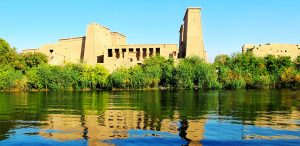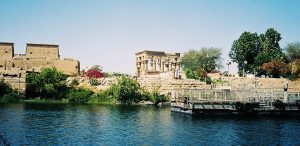+20 2 3762 0904 / +372 5923 9322 /
+44 745 225 4645
Introducción sobre El Templo de Philae
Si los templos de Luxor, Karnak y Hatshepsut son los más destacados de Luxor, el Templo de Philae, es sin lugar a dudas, el más importante de la ciudad de Asuán.
Está dedicado al culto a Isis, una diosa muy popular en el Antiguo Egipto e incluso en el Imperio Romano.
Ubicación Geográfica
El Templo de Philae está ubicado actualmente en la Isla Agilika en Asuán, cerca de la Gran Represa. Se accede a esta isla en aproximadamente 10 minutos de viaje en lancha.
Origen del Nombre
Philae proviene del idioma griego y significa el amado o seres queridos. La isla y el templo tenían el nombre de Bilac (que significa “el final” o “la frontera”) durante el Período Copto. Esto se debe a que la isla era uno de los puntos más australes del país en ese momento.
Historia
Muchos templos fueron construidos en la Isla de Philae. El más antiguo de éstos, fue construido durante el reinado de Nectanebo I, en el siglo IV a.C. y las ruinas más recientes datan del siglo II a.C.
El culto a Isis se extendió a otras partes del imperio griego y romano. Cuando los romanos conquistaron Egipto, reconocieron la importancia del Templo de Philae y realizaron sus contribuciones, añadiendo diferentes estructuras al mismo. Por ejemplo, Julio César construyó un templo en la sección norte de Philae. Los emperadores Justiniano y Adriano también agregaron otras construcciones al templo.
Rescate y Reubicación del Templo de Philae
Luego de la construcción de la Gran Represa de Asuán en 1970, diversos templos de la zona quedaron bajo el agua y debido al movimiento de ésta para generar electricidad, se producían olas altas que estaban erosionando las piedras de los monumentos.
Ante la inevitable pérdida del templo si continuaba inundado, la comunidad internacional junto con el gobierno egipcio decidieron trasladarlo a la cercana Isla de Agilika.
El proyecto de rescate comenzó en 1972. Se pusieron unas 3000 barras de acero alrededor de la isla para evitar las olas del Nilo. Posteriormente, arqueólogos y cientos de trabajadores tomaron fotos de cada parte del templo y luego se empezó a desmantelarlo, roca por roca, enumerando cada una. La etapa siguiente fue trasladarlas y ordenarlas en el sitio nuevo.
Descripción
A la entrada, lo primero que se observa es el Kiosco de Nectanebo, construido en el siglo IV. Es la parte más antigua del templo.
Luego se accede a un gran patio rodeado de columnas grandes que conducen al templo propiamente dicho. Éste se caracteriza por ser una mezcla de los estilos arquitectónicos egipcios y grecorromanos.
El primer pilono conduce a otro patio con columnas y a un segundo pilono construido por Ptolomeo XII.
Dentro del templo está el “Mammissi” o sala del nacimiento, donde están representados Ptolomeo VI, VIII y X.
El pequeño templo de Hathor se encuentra al este del templo principal y está caracterizado por hermosas escenas de cantantes, músicos y el dios Bes entre ellos.
El Kiosco de Trajano tiene 14 columnas y contiene escenas del emperador romano con los dioses egipcios.
La visita al Templo de Philae está incluida en casi todos los viajes que visitan Asuán. Con su hermosa arquitectura y decoración, su magia y emplazamiento, este templo es uno de los más bellos de Egipto.
The PhilaeTemple is for sure the most important highlight of the marvelous City of Aswan. Hundreds of tourists who travel to Egypt visit the Philae Temple every day to view the magnificent and the greatness of the ancient Egypt construction and architectural works.
Dedicated to the worship of the goddess Isis. Isis is a goddess that became quite popular in ancient Egypt and other sections of the Roman Empire, the Philae Temple was the center of the worship of Isis and a common Pilgrimage site of ancient Egypt.
The Temple is now located on the Agilika Island in Aswan, near the Aswan Dam and The High Dam. Tourists usually take a bus or a car from their hotels or Nile Cruises, reach the shores of the River Nile and take a motorboat to reach the Agilika site after a short ride for around 10 minutes.
The origin of the name Philae goes back to the Greek language and it means “the beloved one” or “the beloved ones”. The island and the Temple of Philae had another name as well during the Coptic period in Egypt. This name was “Bilac” which means “the end” or “the border”. This was because the Philae Island was the last section of Egypt during this period of time.
A temple complex was constructed on the Island of Philae. The most ancient among these ancient Egyptian constructions is that temple of isis constructed during the ruling period of Tuthmosis III in the 15th century BC of ancient Egypt.

However, the Philae Temple that still amazes the people who come from all over the world to visit Egypt was finished in 116 BC during the Ptolemaic period in Egypt. Many other Ptolemaic rulers of Egypt have also added their own contributions to this magnificent Temple.
The cult of Isis was spread from Egypt to other destinations like Rome and some sections of the Greek Empire. When the Romans took control of Egypt, the Roman Emperors recognized the importance of the Philae Temple complex and they built many additions to these temples.
This includes Julius Cesar who constructed a temple in the Northern section of the Philae. Moreover, many Roman and Byzantine Emperors had their own additions and buildings in the Philae Temple. This includes Justinian and Hadrian.
Afterwards, after the construction of the High Dam in the 1960s, the situation has completely changed. This was because the site of the Island of Philae was located in the middle between the new High Dam and the old Aswan Dam that meant that most of the sections would be drowning under the water of the River Nile all year long.

When the international community met to discuss the ways to rescue the monuments of the Island, there was a project presented by the Egyptian government to relocate these historical sites to the Agilika Island that was accepted by all the parties who participated in this project.
The project of the rescue of the monuments started in 1972. This was when large ships started positioning 3000 steel rods around the island to temporarily protect this ancient Egyptian site against the water and the waves of the River Nile.
Afterwards, archaeologists and hundreds of workers started taking photos of the different sections of the temple. Afterwards, they began dismantling the rocks and numbering them. The next stage was to transfer the rocks and putting them back in the same order as they were originally constructed and put it in a higher ground. Thank god they succeeded in rescuing this wonderful monument of ancient Egypt.
Today, guests coming from all over the world to tour Egypt to view and admire the greatness of ancient Egypt take boats to reach the Southern section of Agilika Island to witness the great complex of Philae.

A large passageway that is surrounded by large columns leads the guests to the wonderful Temple of Isis, the main section of the Temple that is featured by the mix between ancient Egypt and the Greco-Roman styles of architecture.
Afterwards, the guest views the first pylon that was constructed by Ptolemy XII. The pylon has some scenes of the king defeating his enemies while the gods; Isis, Hathor, and Horus are watching to give such power to the king.

The small temple of Hathor that is featured with its wonderful scenes of singer and musicians with the god Bes among them, now occupies the Eastern side of the Island.
Nearby, there is the magnificent kiosk of Trajan that is famous for its amazing 14 huge columns that contain scenes of the Roman Emperor; Trajan being incensed by the gods.
The Temple of Philae is almost included in all Egypt travel packages that include a visit to the wonderful cities of Luxor and Aswan. With its marvelous architecture, decoration and its own unique magic and ambiance, it always amazes the guests of Egypt.